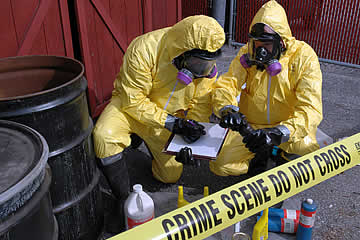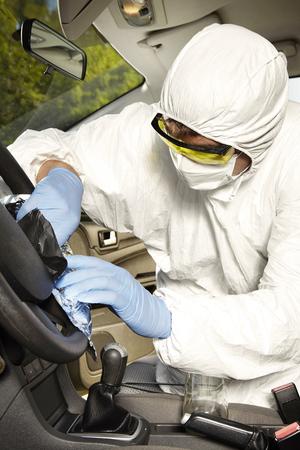Specialist Biohazard Cleansing and Purification for Blood, Bodily Fluids, and Hazardous Products
The potential health and wellness threats connected with direct exposure to biohazards underscore the vital demand for precise handling and detailed cleanup. As we navigate the detailed landscape of biohazard cleanup, comprehending the subtleties of regulations, compliance, and the specific tools at play ends up being essential in making sure a secure and comprehensive decontamination process.
Health And Wellness Dangers of Biohazard Direct Exposure
Direct exposure to biohazards postures significant health dangers that can lead to serious repercussions for areas and people alike. Biohazards encompass a variety of organic compounds, consisting of blood, bodily liquids, mold and mildew, germs, infections, and various other possibly contagious materials. When individuals enter contact with these biohazards, whether with mishaps, incorrect handling, or environmental exposure, they face the risk of having significant illnesses or diseases.
Among the key health and wellness dangers connected with biohazard exposure is the transmission of infectious diseases. Bloodborne virus such as HIV, liver disease B and C, and different germs can be present in biohazardous materials, posturing a straight danger to human health and wellness. Inhaling air-borne biohazards like mold and mildew spores or coming into contact with contaminated surface areas can additionally cause breathing issues, allergies, and various other negative health and wellness effects.
Furthermore, biohazard direct exposure can have long-lasting health implications, with some conditions materializing years after the initial call (Blood Cleanup). Consequently, it is critical to focus on proper biohazard cleansing and decontamination to mitigate these wellness dangers and ensure the safety and security of areas and individuals

Specialized Training for Biohazard Clean-up
When it comes to dealing with biohazard cleaning effectively and safely, specialized training plays an essential function in guaranteeing appropriate purification procedures are followed. Biohazard cleanup calls for certain expertise and abilities to effectively alleviate risks related to bloodborne pathogens, physical liquids, and dangerous products. Experts trained in biohazard clean-up go through extensive guideline on exactly how to securely manage, get rid of, and get rid of biohazardous materials to stop contamination and direct exposure.
Specialized training for biohazard cleaning covers a variety of essential topics, including proper individual safety tools (PPE) use, bloodborne virus recognition, purification strategies, and contaminated materials disposal methods. People educated in biohazard clean-up are geared up with the required experience to analyze contamination degrees, recognize possible risks, and implement appropriate cleaning treatments in conformity with regulative standards.
Continual training and education and learning are vital in the field of biohazard cleanup to remain upgraded on the most current decontamination technologies, safety and security procedures, and policies. By buying specialized training, biohazard cleaning experts can efficiently react to emergency situation cleanup scenarios and secure both public health and wellness and the environment.
Relevance of Appropriate Decontamination Strategies
Utilizing correct decontamination techniques is critical in biohazard clean-up to effectively decrease and get rid of dangerous products health threats. Effective purification not only makes sure the removal of noticeable traces of blood, bodily liquids, and other biohazards however also targets undetectable pathogens that may posture major wellness risks otherwise properly removed. By following strict purification protocols, trained specialists can considerably reduce the threat of direct exposure to unsafe microorganisms, infections, and bacteria that might bring about infections or diseases.
Correct decontamination methods entail making use of specific devices and anti-bacterials that are specifically created to counteract biohazards efficiently. Detailed cleaning and sanitation of infected locations are important to stop the spread of microorganisms and guarantee a safe atmosphere for owners. In addition, the correct disposal of biohazardous waste following decontamination procedures is important in avoiding contamination of other surfaces or individuals.

Devices and Tools for Safe Cleanup
When dealing with blood, physical fluids, or dangerous materials, biohazard cleaning experts rely on specialized gear to decrease exposure dangers and extensively decontaminate the afflicted location. Additionally, biohazard cleaning sets containing disinfectants, absorptive products, and biohazard bags are used to safely get rid of and have of contaminated products.
Advanced cleansing devices like hospital-grade anti-bacterials, HEPA-filtered vacuums, and fogging makers are used to sanitize surfaces and eliminate biohazards successfully. Specialized tools such as sharps containers and biohazard garbage disposal bins view publisher site are utilized to safely handle sharp items and biohazardous waste products. By making use of the appropriate equipment and tools, biohazard cleaning professionals can guarantee a detailed cleanup process that prioritizes safety and minimizes health risks for both workers and residents of the afflicted area.
Laws and Compliance in Biohazard Cleaning
Proper adherence to regulations and compliance standards is critical in biohazard cleaning to ensure the safety of both personnel and the environment. Federal government firms such as OSHA (Occupational Security and Health And Wellness Administration) and the EPA (Epa) have developed details standards for biohazard clean-up procedures to reduce health threats and ecological contamination. These guidelines cover a variety of aspects consisting of the handling, transport, and disposal of visit the site biohazardous materials, as well as the necessary training and safety devices required for employees entailed in the clean-up process.
Biohazard cleansing business must remain updated with these policies to assure that their procedures satisfy the required safety and security requirements. Failure to adhere to these policies can result in serious consequences, consisting of fines, lawsuit, and endangering the wellness of people and the environment. By adhering to strict laws and compliance measures, biohazard cleansing companies can successfully mitigate threats and guarantee a safe and detailed clean-up procedure for all parties entailed.
Conclusion
Finally, biohazard cleaning and decontamination call for specialized training, appropriate strategies, and adherence to policies. Direct exposure to blood, physical fluids, and harmful products positions substantial health dangers, making it critical to use the ideal tools and tools for risk-free cleaning. By adhering to strict procedures and standards, specialists can efficiently alleviate the threats related to biohazard exposure and make sure the safety and security of both themselves and others.
As we browse the detailed landscape of biohazard cleanup, understanding the nuances of guidelines, conformity, and the customized tools at play becomes imperative in guaranteeing a detailed and safe decontamination process. (Blood Cleanup)
When it comes to dealing with biohazard cleanup efficiently and safely, specialized training plays a fundamental role in guaranteeing appropriate decontamination procedures are followed.Utilizing proper decontamination strategies is crucial in biohazard cleanup to properly eliminate hazardous products and decrease health and wellness risks. Additionally, biohazard cleansing packages consisting of disinfectants, absorbent products, and biohazard bags are made use of to securely include and get rid of of contaminated things.
Federal government companies such as OSHA (Occupational Safety and Wellness Management) and the EPA (Environmental Protection Agency) have actually established specific standards for crime scene cleanup near me biohazard clean-up procedures to decrease health and wellness risks and ecological contamination.
Comments on “Specific ATP Testing for Effective Hygiene and Health Surveillance”